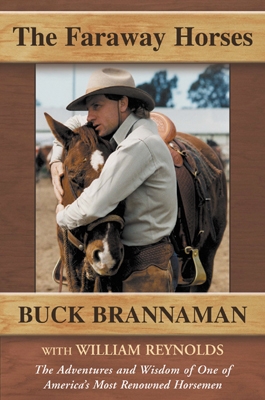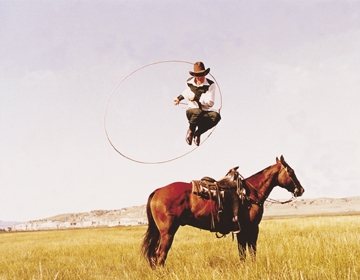Buck Brannaman lives with his wife, Mary, and their three daughters on a 1200-acre ranch in Sheridan, Wyoming. But most often he can be found on the horsemanship clinic circuit somewhere in the USA, offering help to people who have problems with their horses, and most certainly helping horses who have problems with people.
.JPG) In a world that has, in recent years, become relatively well populated with “horse whisperers,” Buck Brannaman stands apart from the others. Still a young man by most accounts, Buck makes a point to honor his elders -- Ray Hunt, Tom Dorrance and Bill Dorrance. And rightly so, because his lineage is directly through that line. But those teachings, the concepts and practices, gained a wider audience in the 1990's, with Hollywood’s own rendition of what this mysticism is all about - the big screen version of the best selling novel, The Horse Whisperer, starring Robert Redford. Buck Brannaman who served as the role model and double for Redford's character, emerged as one who embodies the truth of it all. He’s got it! He shares it with others through his clinics. But most importantly, he lives it. In a world that has, in recent years, become relatively well populated with “horse whisperers,” Buck Brannaman stands apart from the others. Still a young man by most accounts, Buck makes a point to honor his elders -- Ray Hunt, Tom Dorrance and Bill Dorrance. And rightly so, because his lineage is directly through that line. But those teachings, the concepts and practices, gained a wider audience in the 1990's, with Hollywood’s own rendition of what this mysticism is all about - the big screen version of the best selling novel, The Horse Whisperer, starring Robert Redford. Buck Brannaman who served as the role model and double for Redford's character, emerged as one who embodies the truth of it all. He’s got it! He shares it with others through his clinics. But most importantly, he lives it.
So who is this remarkable man who was performing trick roping in television commercials at the age of six, who has started over 10,000 colts in his 20 years of clinic work, and who not only served as advisor on the set of The Horse Whisperer, but was in fact the primary role model used by Nicolas Evans when he crafted the best selling novel bearing the same name!
 The Faraway Horses is an autobiographical foray into Buck’s past both near and far -- his early years of childhood living with an angry abusive father, his mother’s death, his move to a foster home at the age of eleven, his young adult years of struggle for survival punctuated by romance and adventure, his experiences on the set with The Horse Whisperer -- and through it all, his inevitable and deeply intertwined involvement with horses. Scenes unfold that appear to be the backdrop of his life until suddenly what emerges is a direct line, a cause and effect relationship --transformative events that turned fear to trust and destruction to salvation. The Faraway Horses is an autobiographical foray into Buck’s past both near and far -- his early years of childhood living with an angry abusive father, his mother’s death, his move to a foster home at the age of eleven, his young adult years of struggle for survival punctuated by romance and adventure, his experiences on the set with The Horse Whisperer -- and through it all, his inevitable and deeply intertwined involvement with horses. Scenes unfold that appear to be the backdrop of his life until suddenly what emerges is a direct line, a cause and effect relationship --transformative events that turned fear to trust and destruction to salvation.
In a poignant chapter called “The Buckskin Gloves,” Buck brilliantly draws the parallel between a horse who has been abused and mistreated and his own childhood experiences. Buck’s abusive father caused him to taste first hand the horror of not knowing if he would live to see another day. This depth of fear can be the same for a horse, who by nature views the human as a predator. After Buck’s mother died, his father’s abuse became so bad that he and his brother were put in a foster home. The foster parents were older couple named Forrest and Betsy Shirley who lived on a ranch near Bozeman, Montana, and who had the experience under their belt of having raised four kids of their own and having provided a home for some period of time to seventeen other foster boys. The good news was that the Shirleys had the wisdom to provide a balance of proactive discipline, leadership, and direction along with loving, sympathy and support. In this atmosphere Buck gained self confidence; he began to get good grades in school and to get along in general.
 Buck explains that if the Shirleys had felt sorry for him and treated him special, that he would have become spoiled. He points out that a horse can become spoiled too. The Shirleys provided direction and discipline along with caring and support - not the harsh discipline of force, but the kind of discipline that says, “Not that; do this instead.” Buck explains that if the Shirleys had felt sorry for him and treated him special, that he would have become spoiled. He points out that a horse can become spoiled too. The Shirleys provided direction and discipline along with caring and support - not the harsh discipline of force, but the kind of discipline that says, “Not that; do this instead.”
The horse needs direction, too. Buck says, “That time in my life, from the first day on the Shirley’s ranch, made me understand the needs of horses that have been treated poorly and are scared or troubled. You can’t just fix things by showing them love while doing nothing with them. You have to give them some direction, a purpose, a job. They need something to do, a direction to take, a vision of the future so that the past eventually becomes irrelevant.”
The Shirleys may have provided Buck with the opportunity, but it was Buck himself who made the choice to use his experiences to his own betterment. Events from his childhood could have left crippling scars causing him to shrink from life. Instead he uses everything -- both the father’s abuse, and the Shirleys’ guidance -- as valuable lessons that have given him tools to use in his work with horses and in his life in general. According to Buck, being an adult is about choice. He has made being accountable a living philosophy, and in doing so, he becomes an inspiration to others to stand up, assume responsibility, and take charge of one’s life. And, on top of that, folks can learn quite a bit about working with horses while they’re at it.
(Available through publisher, Lyons Press [web site: lyonspress.com. Phone: 212-620-9580]
Photos provided courtesy of William Reynolds, co-author, and associate publisher of Cowboys & Indians Magazine.) |